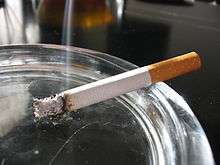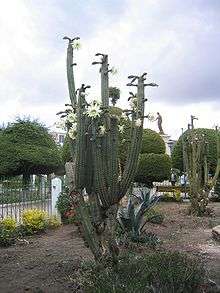Drug

A drug is any substance other than food, that when inhaled, injected, smoked, consumed, absorbed via a patch on the skin or dissolved under the tongue causes a physiological change in the body.[3][4]
In pharmacology, a pharmaceutical drug or medicine, is a chemical substance used to treat, cure, prevent, diagnose a disease or promote well-being.[3] Traditionally drugs were obtained through extraction from medicinal plants, but more recently also by organic synthesis.[5] Pharmaceutical drugs may be used for a limited duration, or on a regular basis for chronic disorders.[6]
Pharmaceutical drugs are often classified into drug classes—groups of related drugs that have similar chemical structures, the same mechanism of action (binding to the same biological target), a related mode of action, and that are used to treat the same disease.[7][8] The Anatomical Therapeutic Chemical Classification System (ATC), the most widely used drug classification system, assigns drugs a unique ATC code, which is an alphanumeric code that assigns it to specific drug classes within the ATC system. Another major classification system is the Biopharmaceutics Classification System. This classifies drugs according to their solubility and permeability or absorption properties.[9]
Psychoactive drugs are chemical substances that affect the function of the central nervous system, altering perception, mood or consciousness.[10] They include alcohol a depressant, and the stimulants nicotine and caffeine. These three are the most widely consumed psychoactive drugs worldwide[11] and are also considered as recreational drugs since they are used for pleasure rather than medicinal purposes.[12] Other recreational drugs include hallucinogens, opiates and amphetamines and some of these are also used in spiritual or religious settings. Some drugs can cause addiction [13] and all drugs can have side effects.[14] Excessive use of stimulants can promote stimulant psychosis. Many recreational drugs are illicit and international treaties such as the Single Convention on Narcotic Drugs exist for the purpose of their prohibition.
Etymology
In English, the noun "drug" is thought to originate from Old French "drogue", possibly deriving later into "droge-vate" from Middle Dutch meaning "dry barrels", referring to medicinal plants preserved in them.[15] The transitive verb "to drug" (meaning intentionally administer a substance to someone, often without their knowledge) arose later and invokes the psychoactive rather than medicinal properties of a substance.[16]
Medication
A medication or medicine is a drug taken to cure or ameliorate any symptoms of an illness or medical condition. The use may also be as preventive medicine that has future benefits but does not treat any existing or pre-existing diseases or symptoms.Dispensing of medication is often regulated by governments into three categories—over-the-counter (OTC) medications, which are available in pharmacies and supermarkets without special restrictions; behind-the-counter (BTC), which are dispensed by a pharmacist without needing a doctor's prescription, and prescription only medicines (POM), which must be prescribed by a licensed medical professional, usually a physician.[17]
In the United Kingdom, BTC medicines are called pharmacy medicines which can only be sold in registered pharmacies, by or under the supervision of a pharmacist. These medications are designated by the letter P on the label.[18] The range of medicines available without a prescription varies from country to country.Medications are typically produced by pharmaceutical companies and are often patented to give the developer exclusive rights to produce them. Those that are not patented (or with expired patents) are called generic drugs since they can be produced by other companies without restrictions or licenses from the patent holder.[19]
Spiritual and religious use
Some religions are based completely on the use of certain drugs, such as entheogens, which are mostly hallucinogens, being either psychedelics or deliriants, but some are also stimulants and sedatives.
Mazatec shamans have a long and continuous tradition of religious use of Salvia divinorum a psychoactive plant. Its use is to facilitate visionary states of consciousness during spiritual healing sessions.[22]
The entheogenic use of cannabis has also been widely practised [23] for centuries.[24]
Smart drugs and Designer drugs
Nootropics, also commonly referred to as "smart drugs", are drugs that are claimed to improve human cognitive abilities. Nootropics are used to improve memory, concentration, thought, mood, learning, and many other things. Some nootropics are now beginning to be used to treat certain diseases such as attention-deficit hyperactivity disorder, Parkinson's disease, and Alzheimer's disease. They are also commonly used to regain brain function lost during aging.
Other drugs known as designer drugs produced, include analogs of performance-enhancing drugs such as designer steroids taken to improve physical capabilities and these are sometimes used (legally or not) for this purpose, often by professional athletes.[25] Other designer drugs mimic the effects of psychoactive drugs. Since the late 1990s there has been the identification of many of these synthesised drugs. In Japan and the United Kingdom this has spurred the addition of many designer drugs into a newer class of controlled substances known as a temporary class drug.
Synthetic cannabinoids have been produced for a longer period of time and are used in the designer drug synthetic cannabis.
Recreational drug use

Recreational drugs use is the use of a drug (legal, controlled, or illegal) with the primary intention of altering the state of consciousness through alteration of the central nervous system in order to create positive emotions and feelings.Some national laws prohibit the use of different recreational drugs, and medicinal drugs that have the potential for recreational use are often heavily regulated. On the other hand, there are many recreational drugs that are legal in many jurisdictions and widely culturally accepted. Cannabis is a mild psychoactive drug and is the most commonly consumed drug in the world (as of 2012).[27]
There may be an age restriction on the consumption and purchase of legal recreational drugs. Some recreational drugs that are legal and accepted in many places include alcohol, tobacco, betel nut, and caffeine products, and in some areas of the world the legal use of drugs such as khat is common.[28]
Administering drugs
Drugs, both medicinal and recreational, can be administered in a number of ways, or routes. Many drugs can be administered via more than one route.
- Bolus is the administration of a medication, drug or other compound that is given to raise its concentration in blood to an effective level. The administration can be given intravenously, by intramuscular, intrathecal or subcutaneous injection.
- Inhaled, (breathed into the lungs), as an aerosol or dry powder. (This includes smoking a substance)
- Injected as a solution, suspension or emulsion either: intramuscular, intravenous, intraperitoneal, intraosseous.
- Insufflation, or snorted into the nose.
- Orally, as a liquid or solid, that is absorbed through the intestines.
- Rectally as a suppository, that is absorbed by the rectum or colon.
- Sublingually, diffusing into the blood through tissues under the tongue.
- Topically, usually as a cream or ointment. A drug administered in this manner may be given to act locally or systemically.[29]
- Vaginally as a pessary, primarily to treat vaginal infections.
See also
References
- ↑ Richard Lovett (24 September 2005). "Coffee: The demon drink?". Retrieved 2014-05-01.
- ↑ According to the statistics of the Food and Agriculture Organization the production quantity in 2006 of coffee was 7.8 million tonnes and of tobacco was 6.7 million tonnes.
- 1 2 "Drug". Dictionary.com Unabridged. v 1.1. Random House. 20 September 2007 – via Dictionary.com.
- ↑ "Drug Definition". Stedman's Medical Dictionary. Retrieved 2014-05-01 – via Drugs.com.
- ↑ Atanasov AG, Waltenberger B, Pferschy-Wenzig EM, Linder T, Wawrosch C, Uhrin P, Temml V, Wang L, Schwaiger S, Heiss EH, Rollinger JM, Schuster D, Breuss JM, Bochkov V, Mihovilovic MD, Kopp B, Bauer R, Dirsch VM, Stuppner H (December 2015). "Discovery and resupply of pharmacologically active plant-derived natural products: A review". Biotechnol Adv 33 (8): 1582–614. doi:10.1016/j.biotechadv.2015.08.001. PMID 26281720.
- ↑ "Drug". The American Heritage Science Dictionary. Houghton Mifflin Company. Retrieved 20 September 2007 – via dictionary.com.
- ↑ Mahoney A, Evans J (6 November 2008). "Comparing drug classification systems". AMIA ... Annual Symposium Proceedings: 1039. PMID 18999016.
- ↑ World Health Organization (2003). Introduction to drug utilization research (PDF). Geneva: World Health Organization. p. 33. ISBN 924156234X.
- ↑ Bergström, CA; Andersson, SB; Fagerberg, JH; Ragnarsson, G; Lindahl, A (16 June 2014). "Is the full potential of the biopharmaceutics classification system reached?". European journal of pharmaceutical sciences : official journal of the European Federation for Pharmaceutical Sciences 57: 224–31. PMID 24075971.
- ↑ http://www.nt.gov.au/health/healthdev/health_promotion/bushbook/volume2/chap1/sect1.htm
- ↑ Crocq MA (June 2003). "Alcohol, nicotine, caffeine, and mental disorders". Dialogues Clin Neurosci. 5 (2): 175–185. PMC 3181622.
- ↑ "Recreational Drug". The Free Dictionary. Retrieved 16 March 2015.
- ↑ Fox, Thomas Peter; Oliver, Govind; Ellis, Sophie Marie (2013). "The Destructive Capacity of Drug Abuse: An Overview Exploring the Harmful Potential of Drug Abuse Both to the Individual and to Society". ISRN Addiction 2013. doi:10.1155/2013/450348. Retrieved 15 April 2015.
- ↑ "MHRA Side Effects of Medicines." MHRA Side Effects of Medicines,
- ↑ Harper, Douglas. "drug". Online Etymology Dictionary.
- ↑ Tupper KW (2012). "Psychoactive substances and the English language: "Drugs," discourses, and public policy.". Contemporary Drug Problems 39 (3): 461–492.
- ↑ "About Registration: Medicines and Prescribing". Health and Care Professions Council. Retrieved 22 January 2016.
- ↑ "Glossary of MHRA terms - P". U.K. Medicines and Healthcare products Regulatory Agency. Retrieved 2008-11-05.
- ↑ "Generic Drugs", Center for Drug Evaluation and Research, U.S. Food and Drug Administration
- ↑ http://www.mescaline.com/sanpedro/
- ↑ Terry M (2013). "Lophophora williamsii". IUCN Red list of threatened species. doi:10.2305/IUCN.UK.2013-1.RLTS.T151962A581420.en.
- ↑ Valdés, Díaz & Paul 1983, p. 287.
- ↑ "Brazilian Archives of Biology and Technology - Jurema-Preta (Mimosa tenuiflora [Willd.] Poir.): a review of its traditional use, phytochemistry and pharmacology". scielo.br. Retrieved 2009-01-14.
- ↑ Bloomquist, Edward (1971). Marijuana: The Second Trip. California: Glencoe.
- ↑ Teale P, Scarth J, Hudson S (2012). "Impact of the emergence of designer drugs upon sports doping testing". Bioanalysis 4 (1): 71–88. doi:10.4155/bio.11.291. PMID 22191595.
- ↑ Lingeman. Drugs from A-Z: A Dictionary. Penguin. ISBN 0-7139-0136-5.
- ↑ "World Drug Report 2012" (pdf). UNODC. 2012. Retrieved 20 September 2014.
- ↑ Al-Mugahed, Leen (2008). "Khat Chewing in Yemen: Turning over a New Leaf: Khat Chewing Is on the Rise in Yemen, Raising Concerns about the Health and Social Consequences". Bulletin of the World Health Organization 86 (10): 741–2. doi:10.2471/BLT.08.011008. PMC 2649518. PMID 18949206. Retrieved 22 January 2016.
- ↑ "The administration of medicines". Nursing Times. EMAP Publishing Limited. 19 November 2007. Retrieved 11 January 2016.
Further reading
- Richard J. Miller (2014). Drugged: the science and culture behind psychotropic drugs. Oxford University Press. ISBN 978-0-19-995797-2.
External links
- DrugBank, a database of 4800 drugs and 2500 protein drug targets
| Wikimedia Commons has media related to Drugs. |
| ||||||||||||||||||||||||||||||||||||||||||||||||||||||||||||||||||||||||||||||||||||||||||||||||||||
| ||||||||||||||||||||||||||||||||||||||||||||||||||||||||||||||||||||||||||||||||||||||||||||||||||||||||
| ||||||||||||||||||||||||||||||||||||||||||||||||||||||||||||||||||||||||||||||||||||||
| ||||||||||||||||||||||||||||||||||||||||||||||||||||||||||||||||||||||||||||||||||
